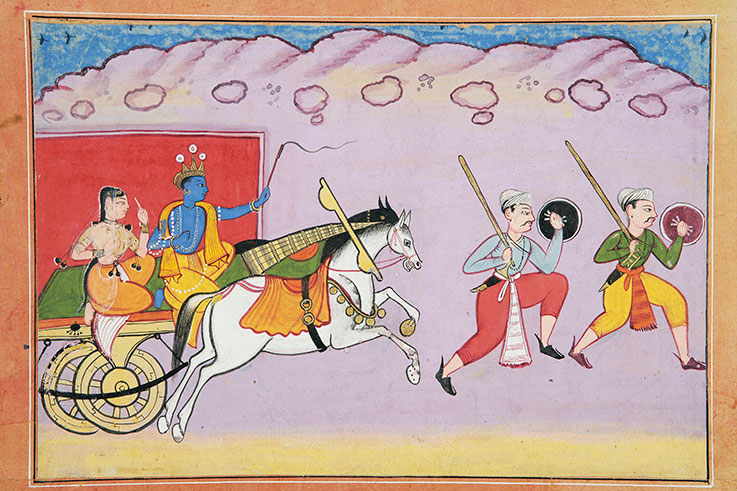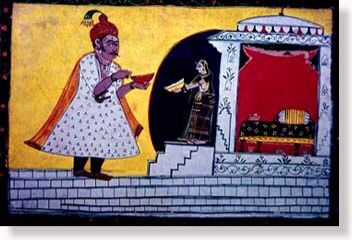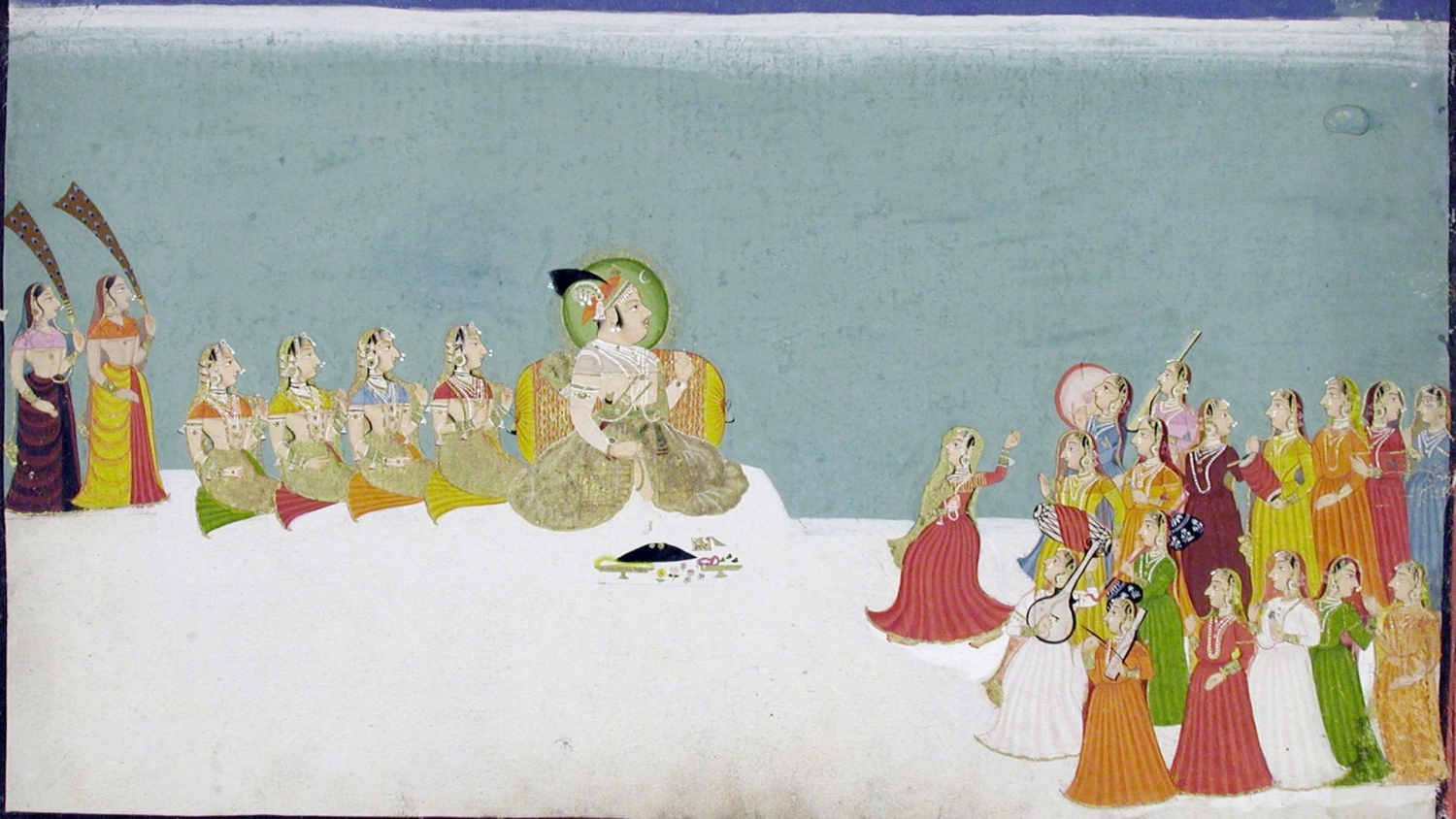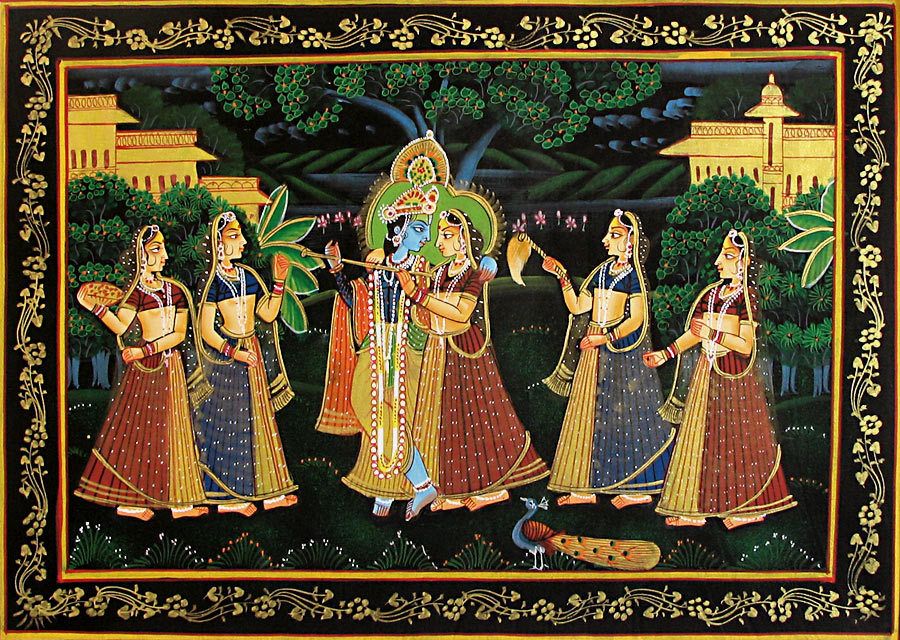Rajput painting, also called Rajasthani painting, evolved and flourished in the royal courts of Rajputana in India. Each Rajputana kingdom evolved a distinct style, but with certain common features. Rajput paintings depict several themes, events of epics like the Ramayana. Miniatures in manuscripts or single sheets to be kept in albums were the preferred medium of Rajput painting, but many paintings were done on the walls of palaces, inner chambers of the forts, Havelis, particularly, the Havelis of Shekhawati, the forts and palaces built by Shekhawat Rajputs.

The colors were extracted from certain minerals, plant sources, conch shells, and were even derived by processing precious stones. Gold and silver were used. The preparation of desired colors was a lengthy process, sometimes taking two weeks. The brushes used were very fine. In the late 16th Century, Rajput art schools began to develop distinctive styles, combining indigenous as well as foreign influences such as Persian, Mughal, Chinese, and European.
The Rajasthani painting consists of four principal schools that have within them several artistic styles and substyles that can be traced to the various princely states that patronized these artists. The four principal schools are, the Mewar school that contains the Chavand, Nathdwara, Devgarh, Udaipur, and Sawar styles of painting; the Marwar school comprising the Kishangarh, Bikaner, Jodhpur, Nagaur, Pali, and Ghanerao styles; The Hadoti school with the Kota, Bundi, and Jhalawar styles; The Dhundar school of Amber, Jaipur, Shekhawati, and Uniara styles of painting.
The economic prosperity of the commercial community and revival of “Vaisnavism” and the growth of the Bhakti Cult were the major factors that contributed greatly to the development of Rajasthani paintings. In the beginning, this style was greatly influenced by religious followers like Ramanuja, Meerabai, Tulsidas, Sri Chaitanya, Kabir, and Ramanand. All of Rajputana was affected by the attack of the Mughals but Mewar did not come under their control till the last. This was the reason that Rajasthani school flourished first in Mewar, (the purest form and later on in), Jaipur, Jodhpur, Bundi, Kota- Kalam, Kishangarh, Bikaner, and other places of Rajasthan.
Bikaner

Rajasthani paintings of Bikaner were also based on Mughal tradition. Apart from the Mughal style, the paintings of Bikaner also reflect the marked influence of Deccan paintings. During the late 18th century, the city started showing conservative Rajput styles with smoothness and abstractions. However, they were devoid of any pomposity and flamboyance.
Bundi

Rajput paintings started originating in Bundi around the late 16th century and reflected heavy Mughal influence. Wall paintings, dating back to the reign of Rao Ratan Singh (1607-1631), are good examples of the Bundi style of paintings. The time of Rao Chattar Sal (1631-1658) and Bhao Singh (1658-1681) saw the great emphasis on court scenes as themes. Other themes include those based on the lives of nobles, lovers, and ladies.
Kota

Kota paintings look very natural in their appearance and are calligraphic in their execution. The reign of Jagat Singh (1658-1684) saw vivacious colors and bold lines being used in portraitures. With the arrival of Arjun Singh (1720-1723), the painting started depicting males with a long hooked nose. The 18th century was also the time for hunting scenes, Ragamalas, and portraits as the themes. Ram Singh II (1827-1866) ordered the depiction of worship, hunting, darbar, and processions in paintings.
Kishangarh

Kishangarh’s style of painting was a fusion of Mughal and regional style. The most common theme of this style consisted of the depiction of the love between Krishna and Radha. Other popular themes included the poetry of Sawant Singh, Shahnama and court scenes, etc. Kishangarh School is best known for its Bani Thani paintings. With the demise of Savant Singh and his leading painters, this school lost its glory and started breaking down.
Malwa

One of the most conservative Rajput Painting Schools of the 17th century, Malwa was highly influenced by Chaurpanchasika style. The emphasis was laid on strong colors and bold lines. At times, one can also observe a remote Mughal influence on these paintings.
Marwar

The earliest example of the Rajasthani paintings of Marwar is that of Ragamala, which was painted in Pali in 1623. In the 18th century, the most common themes included the portraitures of nobles on horses and darbar scenes. With the arrival of artists like Dalchand, Marwar paintings also started reflecting Mughal influence.
Mewar

Mewar school of Rajput paintings concentrated on its conservative style, trying to avoid the dominance of the Mughals. The earliest example of the Mewar School is that of Chawand Ragamala, dating back to 1605. One can observe heavy similarity with the Chaurapanchasika style, especially the flatness, the bright colors, and even common motifs. Towards the end of the 17th century and the early 18th century, the Mewar style saw the revival and the late 18th century again witnessed its decline. From the mid 19th century to mid 20th century, it continued as court art.

